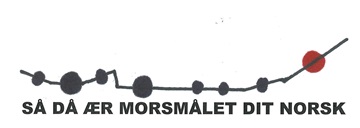So your mother tongue is Norwegian/Danish/Swedish?
In this section, we compare the questions from the overview section (Overview: Intonation in different question types) to the same questions spoken by a speaker of the same language but with a different variety.
Danish
The Jutland Danish question in (48) has a rather linear tonal height throughout the utterance. This is a typical way of pronouncing declarative questions in Danish. In contrast, the Copenhagen speakers all use an alternative pattern: the first two accents are at the same tone height, but the last one the last word, the accented word DANSK (“Danish”), ends in a low tone, as can be heard in the utterance in (48-1). This makes the declination through the whole utterance rather a falling one (for declination, see Tonal movements with functions concerning the whole utterance).
(48) Jutland Danish

(48-1) Copenhagen Danish

Norwegian
The two Southeast Norwegian speakers did not formulate their questions as declarative questions. Instead, one of them formulated a question-word question (So what is…) and the other one a yes/no question (So would you say that…). Only the two South Norwegian speakers used declarative questions. In (49), the South Norwegian declarative question from the overview of question types is repeated. It contains three accent groups. In (49-1), the other South Norwegian declarative question is presented. It is rather monotone and the accent melodies are therefore not that easy to make out. There is a small one accent 1 melody in the accent group MORSmålet dit æ and a big accent 1 melody on the last accent group NORSK (“Norwegian”); however, there are so few voiced speech sounds in NORSK that it is hard to hear the rising accent melody in this word.
(49) South Norwegian

(49-1) South Norwegian

Swedish
The Scania Swedish speaker in (50) distributes prominence in a neutral way, having one accent on MOdersmål and one on SVENska.
The Central Swedish speaker in (50-1) doubles the number of accents by pronouncing a small accent (or primary stress) on the personal pronoun DITT and then another one on the verb E (“is”). There is not much tonal movement on DITT and E, but you can hear the difference compared to the completely unstressed words in the Scania Swedish utterance in (50). The accent on E has the effect of sounding emphatic, like the speaker is assuring that “it is really the case that…”. Putting emphasis on a verb has this effect on the interpretation Scandinavian, German, English and probably more languages utterances.
Both MOdersmål and SVENska are accent 2 words, but only SVENska has a big accent, i.e. it is signaled as conveying the most important information. The big accent 2 melody on SVENska in Central Swedish is easily recognizable by the high tone at the end of the word: SVEN-ska (see Accents: Important information and very important information) After the second high accent melody tone, the tone stays high in this utterance. Since Central Swedish utterances according to the literature always have an end-of-utterance tonal gesture, this indicates that the speaker is using a high end-of-utterance tone. However, this is obviously not an obligatory requirement for declarative questions, as can be heard by the low end-of-utterance tone in the Scania Swedish utterance in (50) (in addition, also the other Scania Swedish speaker uses a low end-of-intonation tone in his declarative question).
(50) Scania Swedish
 (50-1) Central Swedish
(50-1) Central Swedish
